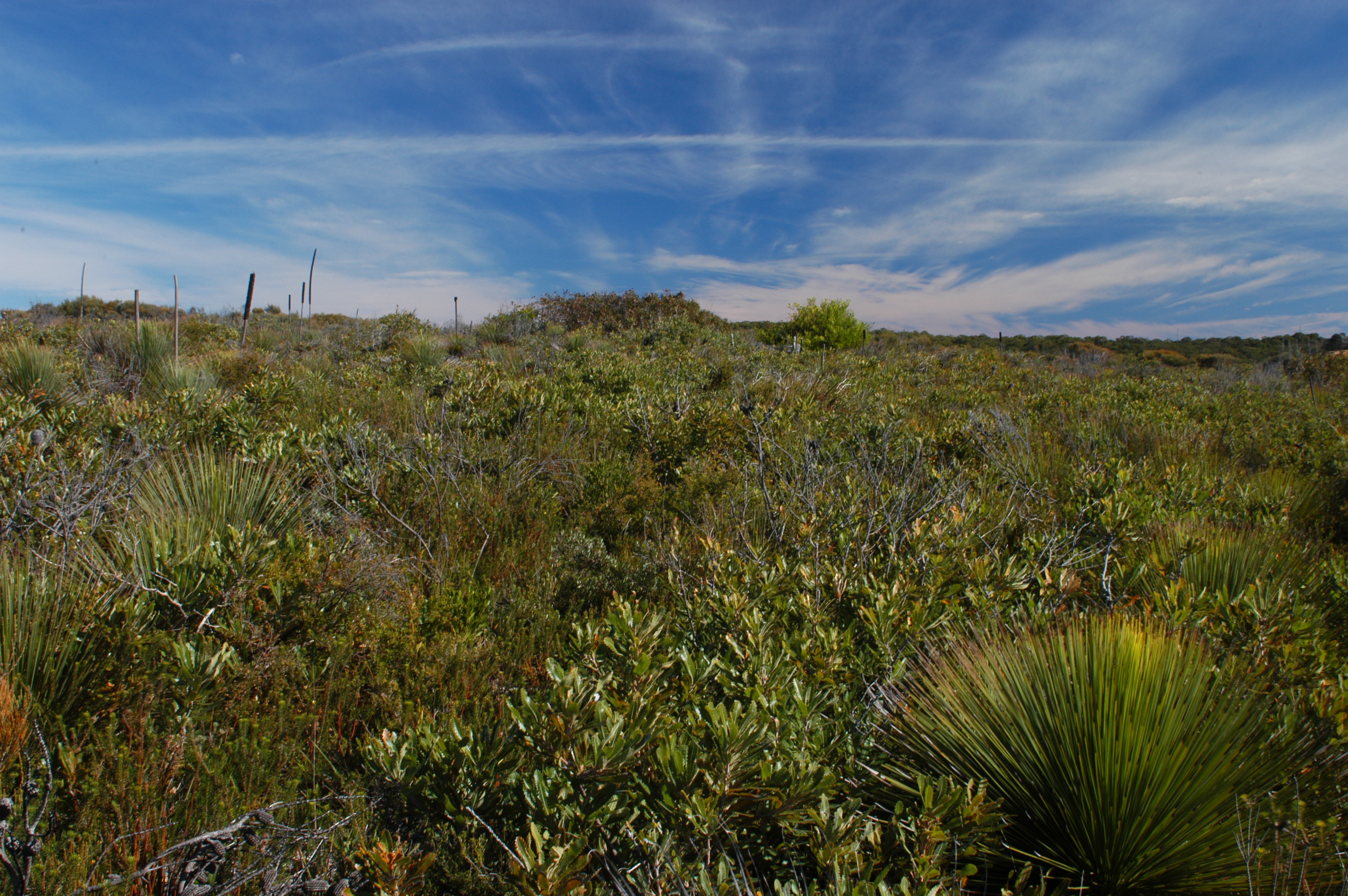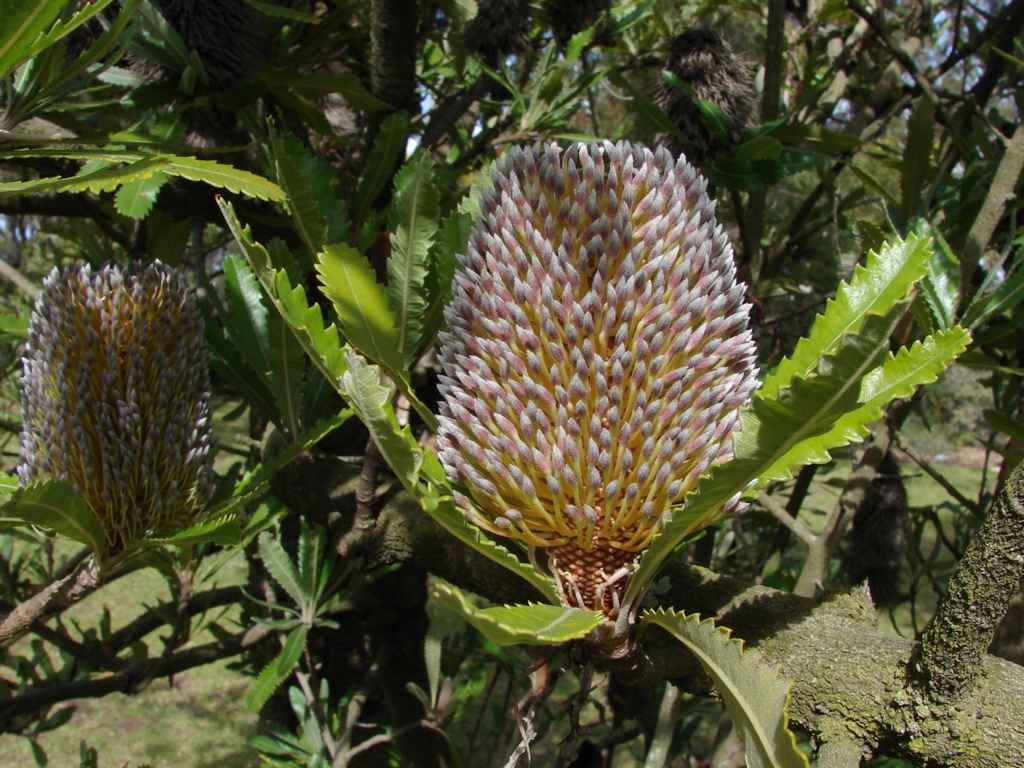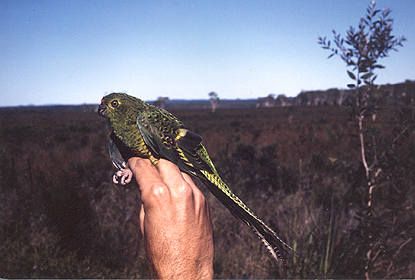|
Wallum
Wallum, or wallum country, is an Australian ecosystem of coastal south-east Queensland, extending into north-eastern New South Wales. It is characterised by flora-rich shrubland and heathland on deep, nutrient-poor, acidic, sandy soils, and regular wildfire A wildfire, forest fire, bushfire, wildland fire or rural fire is an unplanned, uncontrolled and unpredictable fire in an area of combustible vegetation. Depending on the type of vegetation present, a wildfire may be more specifically identi .... Seasonal changes in the water table due to rainfall may create swamps. The name is derived from the Kabi word for the wallum banksia ('' Banksia aemula''). Threats Wallum, as with other coastal ecosystems, is highly threatened by the pressure for coastal development. Threats include clearing of land for residential development and pine plantations, alterations to drainage from adjacent developments, nutrients from fertilizers, changes in fire frequency, pollution from m ... [...More Info...] [...Related Items...] OR: [Wikipedia] [Google] [Baidu] |
Banksia Aemula
''Banksia aemula'', commonly known as the wallum banksia, is a shrub of the family Proteaceae. Found from Bundaberg south to Sydney on the Australian east coast, it is encountered as a shrub or a tree to in coastal heath on deep sandy soil, known as Wallum. It has wrinkled orange bark and shiny green serrated leaves, with green-yellow flower spikes, known as inflorescences, appearing in autumn. The flower spikes turn grey as they age and large grey follicles appear. ''Banksia aemula'' resprouts from its woody base, known as a lignotuber, after bushfires. First described by the botanist Robert Brown in the early 19th century, it derives its specific name "similar" from its resemblance to the closely related '' Banksia serrata''. No varieties are recognised. It was known for many years in New South Wales as ''Banksia serratifolia'', contrasting with the use of ''B.aemula'' elsewhere. However, the former name, originally coined by Richard Anthony Salisbury, proved invalid, a ... [...More Info...] [...Related Items...] OR: [Wikipedia] [Google] [Baidu] |
Wallum Heath 1
Wallum, or wallum country, is an Australian ecosystem of coastal south-east Queensland, extending into north-eastern New South Wales. It is characterised by flora-rich shrubland and heathland on deep, nutrient-poor, acidic, sandy soils, and regular wildfire. Seasonal changes in the water table due to rainfall may create swamps. The name is derived from the Kabi word for the wallum banksia (''Banksia aemula ''Banksia aemula'', commonly known as the wallum banksia, is a shrub of the family Proteaceae. Found from Bundaberg south to Sydney on the Australian east coast, it is encountered as a shrub or a tree to in coastal heath on deep sandy soil, k ...''). Threats Wallum, as with other coastal ecosystems, is highly threatened by the pressure for coastal development. Threats include clearing of land for residential development and pine plantations, alterations to drainage from adjacent developments, nutrients from fertilizers, changes in fire frequency, pollution from mo ... [...More Info...] [...Related Items...] OR: [Wikipedia] [Google] [Baidu] |
Crinia Tinnula
The wallum froglet (''Crinia tinnula'') is a species of ground-dwelling frog native to the east coast of Australia, from southeast Queensland to Kurnell, NSW. It is strongly associated with Wallum swampland. Description This species is a small species of frog, up to 15 mm in length. It is very similar to the common eastern froglet The common eastern froglet (''Crinia signifera'') is a very common, Australian ground-dwelling frog, of the family Myobatrachidae. Distribution The common eastern froglet ranges from southeastern Australia, from Adelaide to Melbourne, up the e ..., and can only readily be distinguished by call and a white stripe on the throat that reaches all the way to the tip on the snout. Its dorsal surface is variable, it can range from grey to brown and is normally smooth in texture. The dorsal surface can be spotted, plain, however it is normally striped. The ventral surface is faintly marbled black and white. Ecology and behaviour This species is conf ... [...More Info...] [...Related Items...] OR: [Wikipedia] [Google] [Baidu] |
Litoria Freycineti
Freycinet's frog (''Litoria freycineti''), also known as the wallum rocket frog, is a species of frog. It inhabits coastal areas from Fraser Island, Queensland, south to the Jervis Bay Territory of New South Wales. Description This is a variable species of frog, reaching 45 mm in length. It is normally brown on the dorsal surface with large lighter or darker patches or raised dots; in some specimens, these patches can be very indistinct to almost nonexistent. A triangular shape of the same colour as the patches is present on the snout, another larger triangular shape is present behind the eyes, almost looking like a reflection to the one on the snout. The iris is a rusty colour in the upper half and brown-grey in the bottom. A white bar extends from in front of the eye around the tympanum and to the arm. The lower lip is marbled black and white. The pads on the fingers are small. The underbelly is white and the throat in males is darker. Ecology and behaviour Despite its ... [...More Info...] [...Related Items...] OR: [Wikipedia] [Google] [Baidu] |
Wallum Froglet
The wallum froglet (''Crinia tinnula'') is a species of ground-dwelling frog native to the east coast of Australia, from southeast Queensland to Kurnell, NSW. It is strongly associated with Wallum swampland. Description This species is a small species of frog, up to 15 mm in length. It is very similar to the common eastern froglet The common eastern froglet (''Crinia signifera'') is a very common, Australian ground-dwelling frog, of the family Myobatrachidae. Distribution The common eastern froglet ranges from southeastern Australia, from Adelaide to Melbourne, up the e ..., and can only readily be distinguished by call and a white stripe on the throat that reaches all the way to the tip on the snout. Its dorsal surface is variable, it can range from grey to brown and is normally smooth in texture. The dorsal surface can be spotted, plain, however it is normally striped. The ventral surface is faintly marbled black and white. Ecology and behaviour This species is conf ... [...More Info...] [...Related Items...] OR: [Wikipedia] [Google] [Baidu] |
Eastern Ground Parrot
The eastern ground parrot (''Pezoporus wallicus'') of Australia is one of only five ground-dwelling parrots in the world, the others being its closest relatives, the western ground parrot (''Pezoporus flaviventris''), the extremely rare night parrot (''Pezoporus occidentalis''), the somewhat closely related Antipodes parakeet (''Cyanoramphus unicolor''), and the unrelated highly endangered kakapo (''Strigops habroptilus'') from New Zealand. The colouration of the three ''Pezoporus'' species and the kakapo is similar – yellowish green with darker barring, somewhat reminiscent of the head and back of the wild-type budgerigar. This is not an indication of a true relationship, however, but either adaptation to a particular lifestyle or a feature retained from ancestral parrots; probably the latter as barred plumage is found all over the family, from the tiny tiger parrots to female cockatiels. When disturbed, a ground parrot flies swiftly just above the ground before dropping b ... [...More Info...] [...Related Items...] OR: [Wikipedia] [Google] [Baidu] |
Land Clearing In Australia
Land clearing in Australia describes the removal of native vegetation and deforestation in Australia. Land clearing involves the removal of native vegetation and habitats, including the bulldozing of native bushlands, forests, savannah, woodlands and native grasslands and the draining of natural wetlands for replacement with agriculture, urban and other land uses. , of the vegetation which existed in Australia at the time of European settlement, approximately 87% remains. One estimate places the rate of rainforest of all types has been reduced by three quarters since the time of European settlement from eight million hectares to two million. Land clearing threatens native species including ground orchids and eucalyptus. Land clearing is an important environmental issue in Australia. Bans on land clearing have been placed by state governments. This policy largely permitted Australia to abide by its commitments to the Kyoto Protocol. Causes The underlying causes of land-cle ... [...More Info...] [...Related Items...] OR: [Wikipedia] [Google] [Baidu] |
Gubbi Gubbi People
The Gubbi Gubbi people also known as Kabi Kabi are an Aboriginal Australian people native to south-eastern Queensland. They are now classified as one of several Murri language groups in Queensland. Naming As is often the case, ethnonyms distinguishing one tribe from another select the word used by any one group for the concept 'no', which is the meaning of ''kabi/gubi/gabi''. However, AIATSIS's Austlang database prefers Gubbi Gubbi, There is a disagreement both about the name and which group(s) represent the nation or peoples known as Gubbi Gubbi or Kabi Kabi. Country John Mathew, who lived among them, described the Gubbi Gubbi lands as roughly coextensive with the Mary River Basin, though stretching beyond it north to the Burrum River and south along the coast itself. He estimated their territory to cover . According to Norman Tindale, however, the Gubbi Gubbi people were an inland group living in the Wide Bay–Burnett area, and their lands extended over and lay ... [...More Info...] [...Related Items...] OR: [Wikipedia] [Google] [Baidu] |
Banksia Aemula1
''Banksia'' is a genus of around 170 species in the plant family Proteaceae. These Australian wildflowers and popular garden plants are easily recognised by their characteristic flower spikes, and fruiting "cones" and heads. ''Banksias'' range in size from prostrate woody shrubs to trees up to 30 metres (100 ft) tall. They are found in a wide variety of landscapes: sclerophyll forest, (occasionally) rainforest, shrubland, and some more arid landscapes, though not in Australia's deserts. Heavy producers of nectar, ''banksias'' are a vital part of the food chain in the Australian bush. They are an important food source for nectarivorous animals, including birds, bats, rats, possums, stingless bees and a host of invertebrates. Further, they are of economic importance to Australia's nursery and cut flower industries. However, these plants are threatened by a number of processes including land clearing, frequent burning and disease, and a number of species are rare and endangered. ... [...More Info...] [...Related Items...] OR: [Wikipedia] [Google] [Baidu] |
Wildfire
A wildfire, forest fire, bushfire, wildland fire or rural fire is an unplanned, uncontrolled and unpredictable fire in an area of combustible vegetation. Depending on the type of vegetation present, a wildfire may be more specifically identified as a bushfire( in Australia), desert fire, grass fire, hill fire, peat fire, prairie fire, vegetation fire, or veld fire. Some natural forest ecosystems depend on wildfire. Wildfires are distinct from beneficial human usage of wildland fire, called controlled burning, although controlled burns can turn into wildfires. Fossil charcoal indicates that wildfires began soon after the appearance of terrestrial plants approximately 419 million years ago during the Silurian period. Earth's carbon-rich vegetation, seasonally dry climates, atmospheric oxygen, and widespread lightning and volcanic ignitions create favorable conditions for fires. The occurrence of wildfires throughout the history of terrestrial life invites conjecture that ... [...More Info...] [...Related Items...] OR: [Wikipedia] [Google] [Baidu] |
Heath (habitat)
A heath () is a shrubland habitat found mainly on free-draining infertile, acidic soils and characterised by open, low-growing woody vegetation. Moorland is generally related to high-ground heaths with—especially in Great Britain—a cooler and damper climate. Heaths are widespread worldwide but are fast disappearing and considered a rare habitat in Europe. They form extensive and highly diverse communities across Australia in humid and sub-humid areas where fire regimes with recurring burning are required for the maintenance of the heathlands.Specht, R.L. 'Heathlands' in 'Australian Vegetation' R.H. Groves ed. Cambridge University Press 1988 Even more diverse though less widespread heath communities occur in Southern Africa. Extensive heath communities can also be found in the Texas chaparral, New Caledonia, central Chile, and along the shores of the Mediterranean Sea. In addition to these extensive heath areas, the vegetation type is also found in scattered locations a ... [...More Info...] [...Related Items...] OR: [Wikipedia] [Google] [Baidu] |








.jpeg/1200px-Amrum_(187753235).jpeg)